Comprehensive Risk Assessment Report for Engineering Project Outcomes
VerifiedAdded on 2023/06/05
|7
|2050
|265
Report
AI Summary
This report provides a comprehensive overview of risk assessment in engineering projects, emphasizing its critical role in achieving better project outcomes. It begins by defining risk assessment as a systematic process for identifying, analyzing, and evaluating potential risks during project execution, highlighting the importance of effective risk planning for project success. The report then discusses the advantages of conducting risk assessments, such as enhancing project understanding and enabling efficient resource allocation. It outlines key processes for incorporating risk assessment, including making assumptions, formulating project constraints, identifying risks, and conducting thorough risk analysis. Furthermore, the report explores various assessment tools and techniques, including quantitative, qualitative, and mixed methods, and emphasizes the significance of stakeholder engagement and effective risk communication strategies for addressing project challenges. The document concludes by referencing relevant research, underscoring the importance of integrating risk management into engineering project management practices. Desklib provides similar solved assignments and past papers for students.
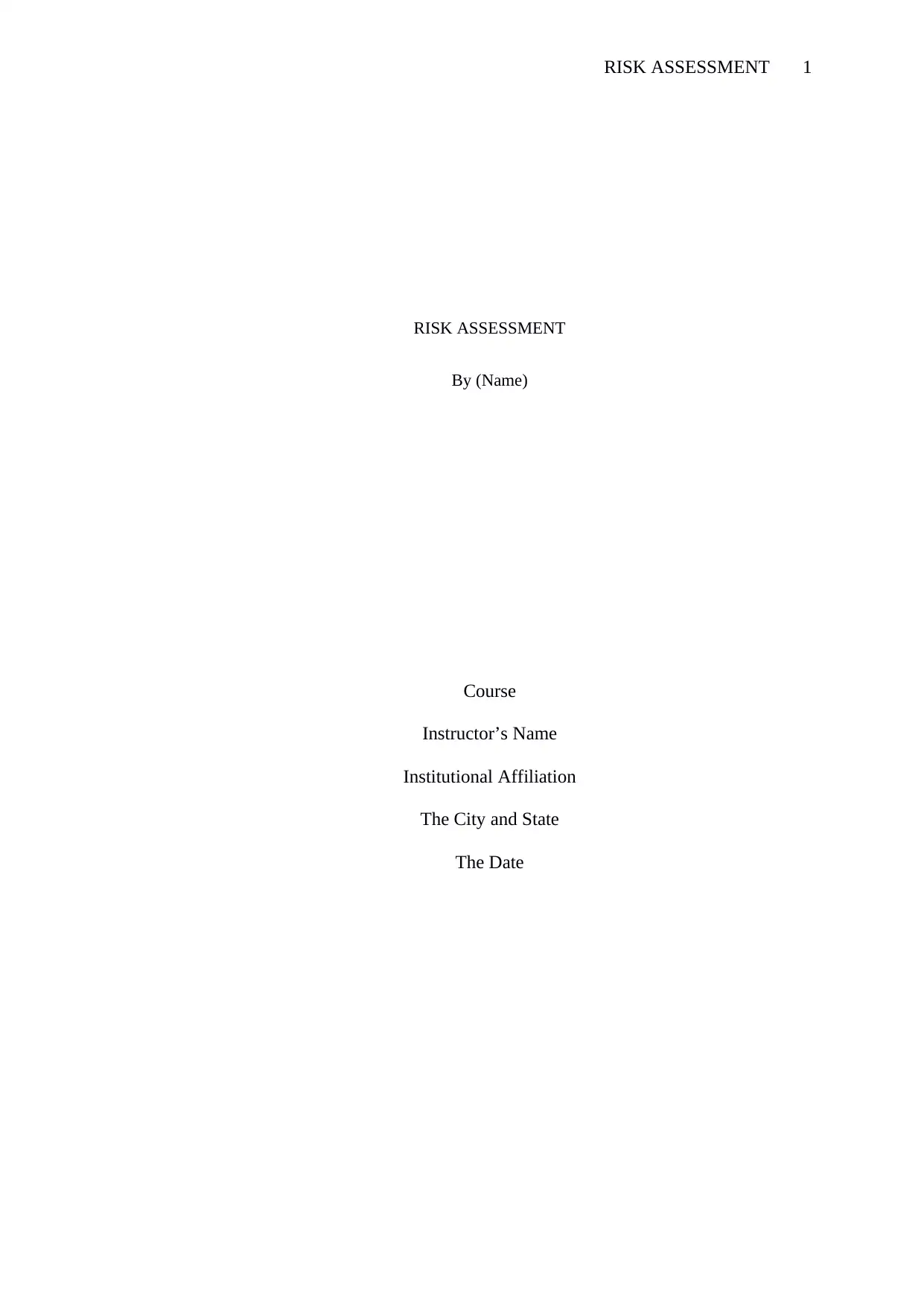
RISK ASSESSMENT 1
RISK ASSESSMENT
By (Name)
Course
Instructor’s Name
Institutional Affiliation
The City and State
The Date
RISK ASSESSMENT
By (Name)
Course
Instructor’s Name
Institutional Affiliation
The City and State
The Date
Paraphrase This Document
Need a fresh take? Get an instant paraphrase of this document with our AI Paraphraser
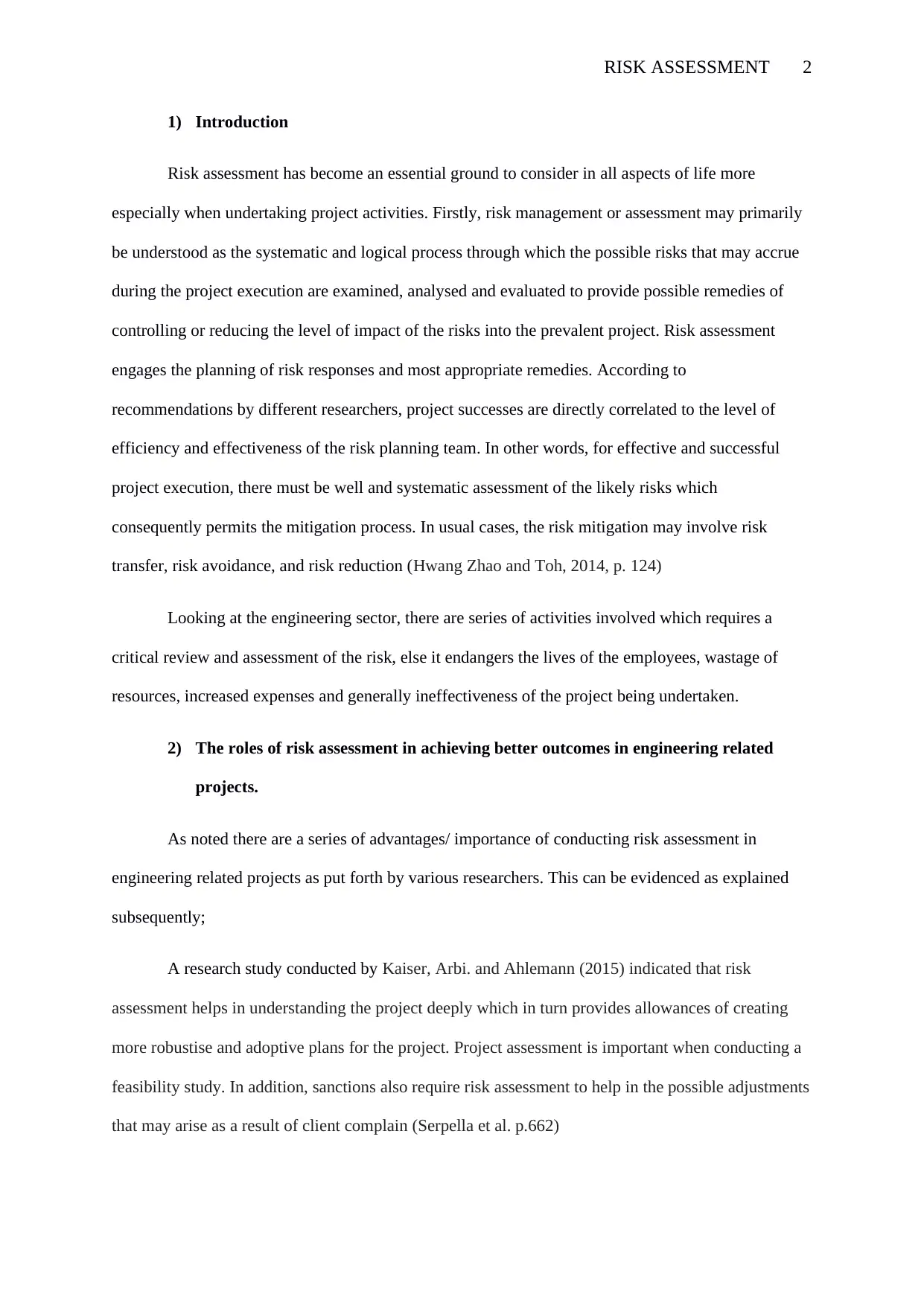
RISK ASSESSMENT 2
1) Introduction
Risk assessment has become an essential ground to consider in all aspects of life more
especially when undertaking project activities. Firstly, risk management or assessment may primarily
be understood as the systematic and logical process through which the possible risks that may accrue
during the project execution are examined, analysed and evaluated to provide possible remedies of
controlling or reducing the level of impact of the risks into the prevalent project. Risk assessment
engages the planning of risk responses and most appropriate remedies. According to
recommendations by different researchers, project successes are directly correlated to the level of
efficiency and effectiveness of the risk planning team. In other words, for effective and successful
project execution, there must be well and systematic assessment of the likely risks which
consequently permits the mitigation process. In usual cases, the risk mitigation may involve risk
transfer, risk avoidance, and risk reduction (Hwang Zhao and Toh, 2014, p. 124)
Looking at the engineering sector, there are series of activities involved which requires a
critical review and assessment of the risk, else it endangers the lives of the employees, wastage of
resources, increased expenses and generally ineffectiveness of the project being undertaken.
2) The roles of risk assessment in achieving better outcomes in engineering related
projects.
As noted there are a series of advantages/ importance of conducting risk assessment in
engineering related projects as put forth by various researchers. This can be evidenced as explained
subsequently;
A research study conducted by Kaiser, Arbi. and Ahlemann (2015) indicated that risk
assessment helps in understanding the project deeply which in turn provides allowances of creating
more robustise and adoptive plans for the project. Project assessment is important when conducting a
feasibility study. In addition, sanctions also require risk assessment to help in the possible adjustments
that may arise as a result of client complain (Serpella et al. p.662)
1) Introduction
Risk assessment has become an essential ground to consider in all aspects of life more
especially when undertaking project activities. Firstly, risk management or assessment may primarily
be understood as the systematic and logical process through which the possible risks that may accrue
during the project execution are examined, analysed and evaluated to provide possible remedies of
controlling or reducing the level of impact of the risks into the prevalent project. Risk assessment
engages the planning of risk responses and most appropriate remedies. According to
recommendations by different researchers, project successes are directly correlated to the level of
efficiency and effectiveness of the risk planning team. In other words, for effective and successful
project execution, there must be well and systematic assessment of the likely risks which
consequently permits the mitigation process. In usual cases, the risk mitigation may involve risk
transfer, risk avoidance, and risk reduction (Hwang Zhao and Toh, 2014, p. 124)
Looking at the engineering sector, there are series of activities involved which requires a
critical review and assessment of the risk, else it endangers the lives of the employees, wastage of
resources, increased expenses and generally ineffectiveness of the project being undertaken.
2) The roles of risk assessment in achieving better outcomes in engineering related
projects.
As noted there are a series of advantages/ importance of conducting risk assessment in
engineering related projects as put forth by various researchers. This can be evidenced as explained
subsequently;
A research study conducted by Kaiser, Arbi. and Ahlemann (2015) indicated that risk
assessment helps in understanding the project deeply which in turn provides allowances of creating
more robustise and adoptive plans for the project. Project assessment is important when conducting a
feasibility study. In addition, sanctions also require risk assessment to help in the possible adjustments
that may arise as a result of client complain (Serpella et al. p.662)
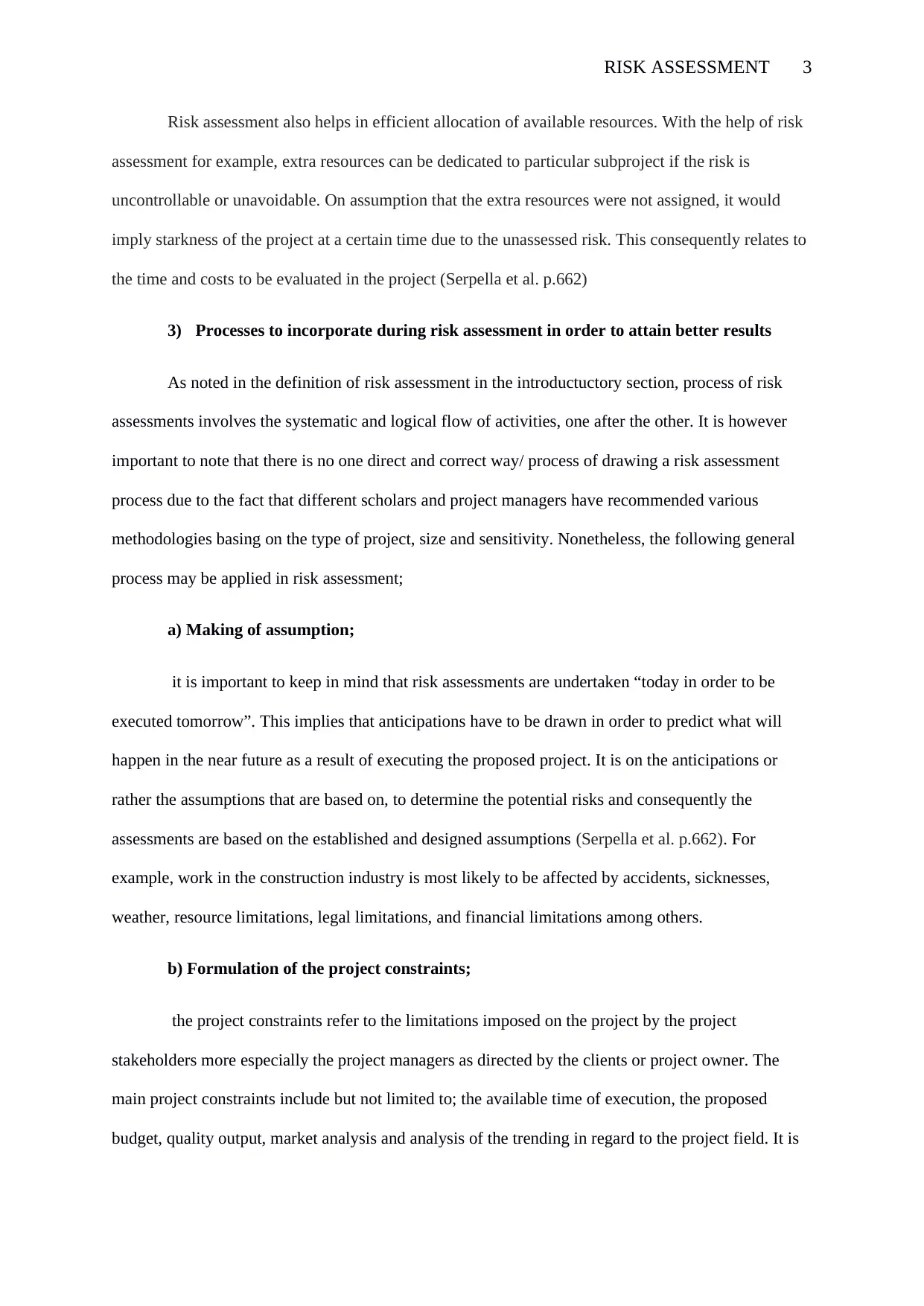
RISK ASSESSMENT 3
Risk assessment also helps in efficient allocation of available resources. With the help of risk
assessment for example, extra resources can be dedicated to particular subproject if the risk is
uncontrollable or unavoidable. On assumption that the extra resources were not assigned, it would
imply starkness of the project at a certain time due to the unassessed risk. This consequently relates to
the time and costs to be evaluated in the project (Serpella et al. p.662)
3) Processes to incorporate during risk assessment in order to attain better results
As noted in the definition of risk assessment in the introductuctory section, process of risk
assessments involves the systematic and logical flow of activities, one after the other. It is however
important to note that there is no one direct and correct way/ process of drawing a risk assessment
process due to the fact that different scholars and project managers have recommended various
methodologies basing on the type of project, size and sensitivity. Nonetheless, the following general
process may be applied in risk assessment;
a) Making of assumption;
it is important to keep in mind that risk assessments are undertaken “today in order to be
executed tomorrow”. This implies that anticipations have to be drawn in order to predict what will
happen in the near future as a result of executing the proposed project. It is on the anticipations or
rather the assumptions that are based on, to determine the potential risks and consequently the
assessments are based on the established and designed assumptions (Serpella et al. p.662). For
example, work in the construction industry is most likely to be affected by accidents, sicknesses,
weather, resource limitations, legal limitations, and financial limitations among others.
b) Formulation of the project constraints;
the project constraints refer to the limitations imposed on the project by the project
stakeholders more especially the project managers as directed by the clients or project owner. The
main project constraints include but not limited to; the available time of execution, the proposed
budget, quality output, market analysis and analysis of the trending in regard to the project field. It is
Risk assessment also helps in efficient allocation of available resources. With the help of risk
assessment for example, extra resources can be dedicated to particular subproject if the risk is
uncontrollable or unavoidable. On assumption that the extra resources were not assigned, it would
imply starkness of the project at a certain time due to the unassessed risk. This consequently relates to
the time and costs to be evaluated in the project (Serpella et al. p.662)
3) Processes to incorporate during risk assessment in order to attain better results
As noted in the definition of risk assessment in the introductuctory section, process of risk
assessments involves the systematic and logical flow of activities, one after the other. It is however
important to note that there is no one direct and correct way/ process of drawing a risk assessment
process due to the fact that different scholars and project managers have recommended various
methodologies basing on the type of project, size and sensitivity. Nonetheless, the following general
process may be applied in risk assessment;
a) Making of assumption;
it is important to keep in mind that risk assessments are undertaken “today in order to be
executed tomorrow”. This implies that anticipations have to be drawn in order to predict what will
happen in the near future as a result of executing the proposed project. It is on the anticipations or
rather the assumptions that are based on, to determine the potential risks and consequently the
assessments are based on the established and designed assumptions (Serpella et al. p.662). For
example, work in the construction industry is most likely to be affected by accidents, sicknesses,
weather, resource limitations, legal limitations, and financial limitations among others.
b) Formulation of the project constraints;
the project constraints refer to the limitations imposed on the project by the project
stakeholders more especially the project managers as directed by the clients or project owner. The
main project constraints include but not limited to; the available time of execution, the proposed
budget, quality output, market analysis and analysis of the trending in regard to the project field. It is
⊘ This is a preview!⊘
Do you want full access?
Subscribe today to unlock all pages.

Trusted by 1+ million students worldwide
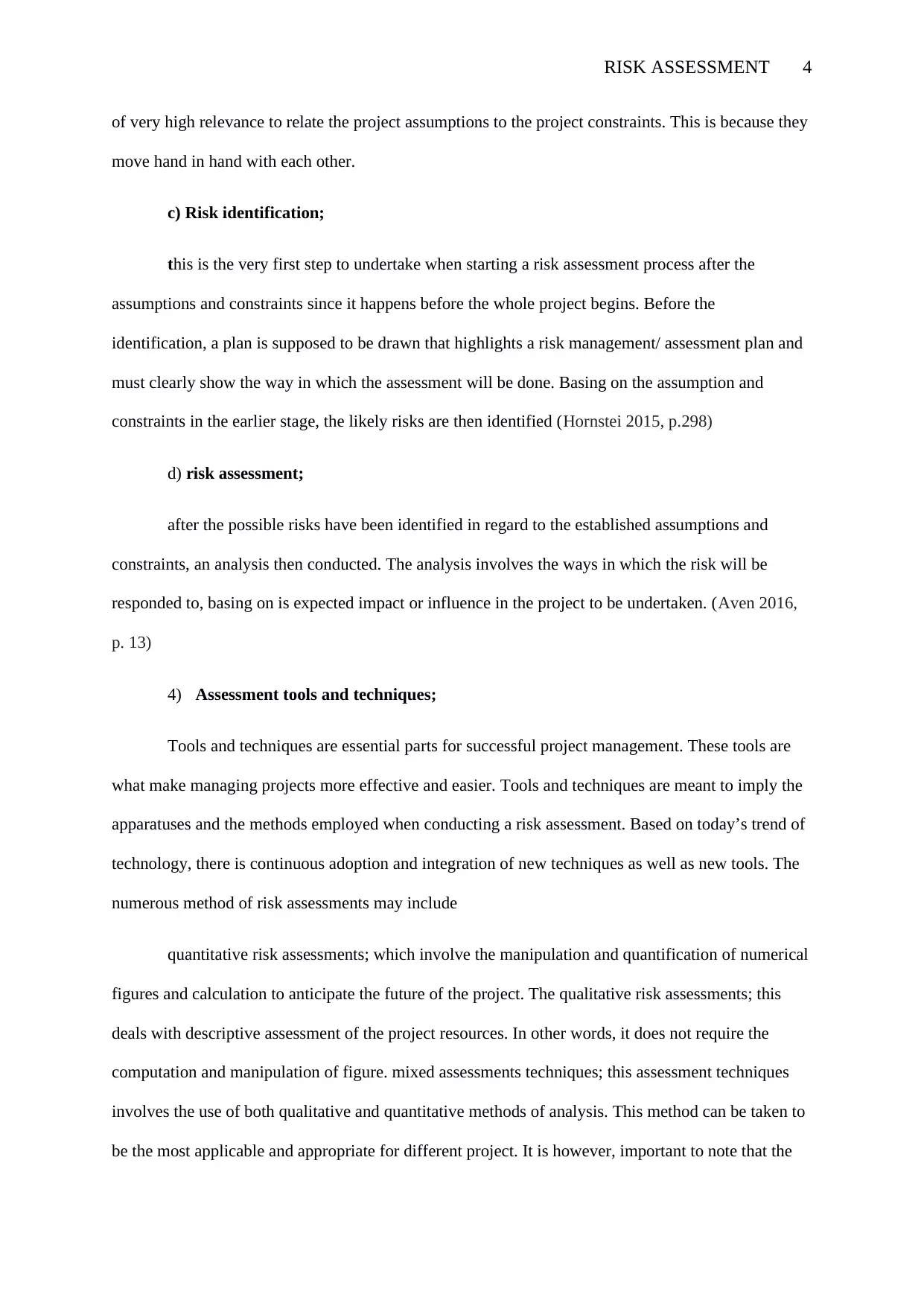
RISK ASSESSMENT 4
of very high relevance to relate the project assumptions to the project constraints. This is because they
move hand in hand with each other.
c) Risk identification;
this is the very first step to undertake when starting a risk assessment process after the
assumptions and constraints since it happens before the whole project begins. Before the
identification, a plan is supposed to be drawn that highlights a risk management/ assessment plan and
must clearly show the way in which the assessment will be done. Basing on the assumption and
constraints in the earlier stage, the likely risks are then identified (Hornstei 2015, p.298)
d) risk assessment;
after the possible risks have been identified in regard to the established assumptions and
constraints, an analysis then conducted. The analysis involves the ways in which the risk will be
responded to, basing on is expected impact or influence in the project to be undertaken. (Aven 2016,
p. 13)
4) Assessment tools and techniques;
Tools and techniques are essential parts for successful project management. These tools are
what make managing projects more effective and easier. Tools and techniques are meant to imply the
apparatuses and the methods employed when conducting a risk assessment. Based on today’s trend of
technology, there is continuous adoption and integration of new techniques as well as new tools. The
numerous method of risk assessments may include
quantitative risk assessments; which involve the manipulation and quantification of numerical
figures and calculation to anticipate the future of the project. The qualitative risk assessments; this
deals with descriptive assessment of the project resources. In other words, it does not require the
computation and manipulation of figure. mixed assessments techniques; this assessment techniques
involves the use of both qualitative and quantitative methods of analysis. This method can be taken to
be the most applicable and appropriate for different project. It is however, important to note that the
of very high relevance to relate the project assumptions to the project constraints. This is because they
move hand in hand with each other.
c) Risk identification;
this is the very first step to undertake when starting a risk assessment process after the
assumptions and constraints since it happens before the whole project begins. Before the
identification, a plan is supposed to be drawn that highlights a risk management/ assessment plan and
must clearly show the way in which the assessment will be done. Basing on the assumption and
constraints in the earlier stage, the likely risks are then identified (Hornstei 2015, p.298)
d) risk assessment;
after the possible risks have been identified in regard to the established assumptions and
constraints, an analysis then conducted. The analysis involves the ways in which the risk will be
responded to, basing on is expected impact or influence in the project to be undertaken. (Aven 2016,
p. 13)
4) Assessment tools and techniques;
Tools and techniques are essential parts for successful project management. These tools are
what make managing projects more effective and easier. Tools and techniques are meant to imply the
apparatuses and the methods employed when conducting a risk assessment. Based on today’s trend of
technology, there is continuous adoption and integration of new techniques as well as new tools. The
numerous method of risk assessments may include
quantitative risk assessments; which involve the manipulation and quantification of numerical
figures and calculation to anticipate the future of the project. The qualitative risk assessments; this
deals with descriptive assessment of the project resources. In other words, it does not require the
computation and manipulation of figure. mixed assessments techniques; this assessment techniques
involves the use of both qualitative and quantitative methods of analysis. This method can be taken to
be the most applicable and appropriate for different project. It is however, important to note that the
Paraphrase This Document
Need a fresh take? Get an instant paraphrase of this document with our AI Paraphraser
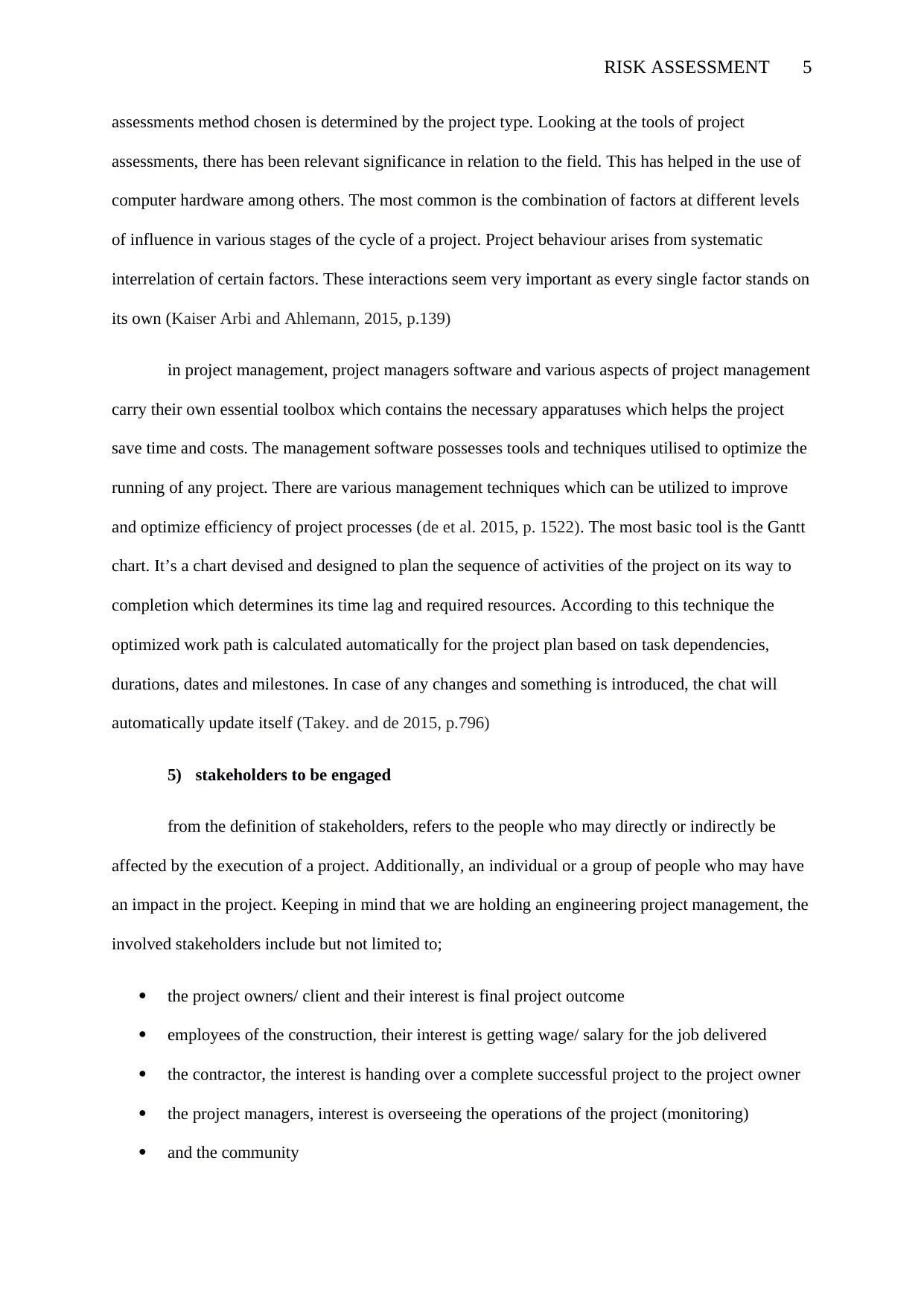
RISK ASSESSMENT 5
assessments method chosen is determined by the project type. Looking at the tools of project
assessments, there has been relevant significance in relation to the field. This has helped in the use of
computer hardware among others. The most common is the combination of factors at different levels
of influence in various stages of the cycle of a project. Project behaviour arises from systematic
interrelation of certain factors. These interactions seem very important as every single factor stands on
its own (Kaiser Arbi and Ahlemann, 2015, p.139)
in project management, project managers software and various aspects of project management
carry their own essential toolbox which contains the necessary apparatuses which helps the project
save time and costs. The management software possesses tools and techniques utilised to optimize the
running of any project. There are various management techniques which can be utilized to improve
and optimize efficiency of project processes (de et al. 2015, p. 1522). The most basic tool is the Gantt
chart. It’s a chart devised and designed to plan the sequence of activities of the project on its way to
completion which determines its time lag and required resources. According to this technique the
optimized work path is calculated automatically for the project plan based on task dependencies,
durations, dates and milestones. In case of any changes and something is introduced, the chat will
automatically update itself (Takey. and de 2015, p.796)
5) stakeholders to be engaged
from the definition of stakeholders, refers to the people who may directly or indirectly be
affected by the execution of a project. Additionally, an individual or a group of people who may have
an impact in the project. Keeping in mind that we are holding an engineering project management, the
involved stakeholders include but not limited to;
the project owners/ client and their interest is final project outcome
employees of the construction, their interest is getting wage/ salary for the job delivered
the contractor, the interest is handing over a complete successful project to the project owner
the project managers, interest is overseeing the operations of the project (monitoring)
and the community
assessments method chosen is determined by the project type. Looking at the tools of project
assessments, there has been relevant significance in relation to the field. This has helped in the use of
computer hardware among others. The most common is the combination of factors at different levels
of influence in various stages of the cycle of a project. Project behaviour arises from systematic
interrelation of certain factors. These interactions seem very important as every single factor stands on
its own (Kaiser Arbi and Ahlemann, 2015, p.139)
in project management, project managers software and various aspects of project management
carry their own essential toolbox which contains the necessary apparatuses which helps the project
save time and costs. The management software possesses tools and techniques utilised to optimize the
running of any project. There are various management techniques which can be utilized to improve
and optimize efficiency of project processes (de et al. 2015, p. 1522). The most basic tool is the Gantt
chart. It’s a chart devised and designed to plan the sequence of activities of the project on its way to
completion which determines its time lag and required resources. According to this technique the
optimized work path is calculated automatically for the project plan based on task dependencies,
durations, dates and milestones. In case of any changes and something is introduced, the chat will
automatically update itself (Takey. and de 2015, p.796)
5) stakeholders to be engaged
from the definition of stakeholders, refers to the people who may directly or indirectly be
affected by the execution of a project. Additionally, an individual or a group of people who may have
an impact in the project. Keeping in mind that we are holding an engineering project management, the
involved stakeholders include but not limited to;
the project owners/ client and their interest is final project outcome
employees of the construction, their interest is getting wage/ salary for the job delivered
the contractor, the interest is handing over a complete successful project to the project owner
the project managers, interest is overseeing the operations of the project (monitoring)
and the community
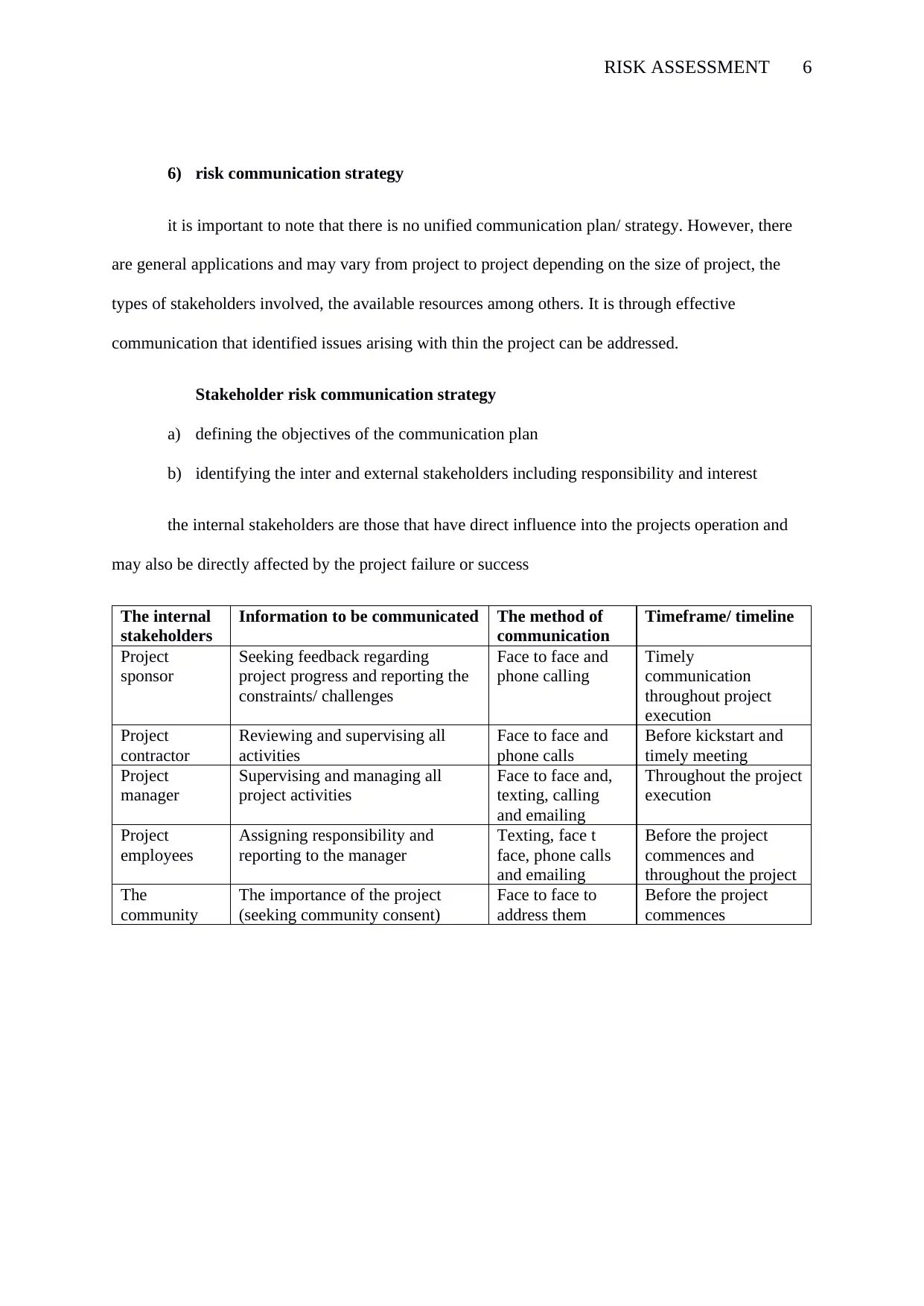
RISK ASSESSMENT 6
6) risk communication strategy
it is important to note that there is no unified communication plan/ strategy. However, there
are general applications and may vary from project to project depending on the size of project, the
types of stakeholders involved, the available resources among others. It is through effective
communication that identified issues arising with thin the project can be addressed.
Stakeholder risk communication strategy
a) defining the objectives of the communication plan
b) identifying the inter and external stakeholders including responsibility and interest
the internal stakeholders are those that have direct influence into the projects operation and
may also be directly affected by the project failure or success
The internal
stakeholders
Information to be communicated The method of
communication
Timeframe/ timeline
Project
sponsor
Seeking feedback regarding
project progress and reporting the
constraints/ challenges
Face to face and
phone calling
Timely
communication
throughout project
execution
Project
contractor
Reviewing and supervising all
activities
Face to face and
phone calls
Before kickstart and
timely meeting
Project
manager
Supervising and managing all
project activities
Face to face and,
texting, calling
and emailing
Throughout the project
execution
Project
employees
Assigning responsibility and
reporting to the manager
Texting, face t
face, phone calls
and emailing
Before the project
commences and
throughout the project
The
community
The importance of the project
(seeking community consent)
Face to face to
address them
Before the project
commences
6) risk communication strategy
it is important to note that there is no unified communication plan/ strategy. However, there
are general applications and may vary from project to project depending on the size of project, the
types of stakeholders involved, the available resources among others. It is through effective
communication that identified issues arising with thin the project can be addressed.
Stakeholder risk communication strategy
a) defining the objectives of the communication plan
b) identifying the inter and external stakeholders including responsibility and interest
the internal stakeholders are those that have direct influence into the projects operation and
may also be directly affected by the project failure or success
The internal
stakeholders
Information to be communicated The method of
communication
Timeframe/ timeline
Project
sponsor
Seeking feedback regarding
project progress and reporting the
constraints/ challenges
Face to face and
phone calling
Timely
communication
throughout project
execution
Project
contractor
Reviewing and supervising all
activities
Face to face and
phone calls
Before kickstart and
timely meeting
Project
manager
Supervising and managing all
project activities
Face to face and,
texting, calling
and emailing
Throughout the project
execution
Project
employees
Assigning responsibility and
reporting to the manager
Texting, face t
face, phone calls
and emailing
Before the project
commences and
throughout the project
The
community
The importance of the project
(seeking community consent)
Face to face to
address them
Before the project
commences
⊘ This is a preview!⊘
Do you want full access?
Subscribe today to unlock all pages.

Trusted by 1+ million students worldwide
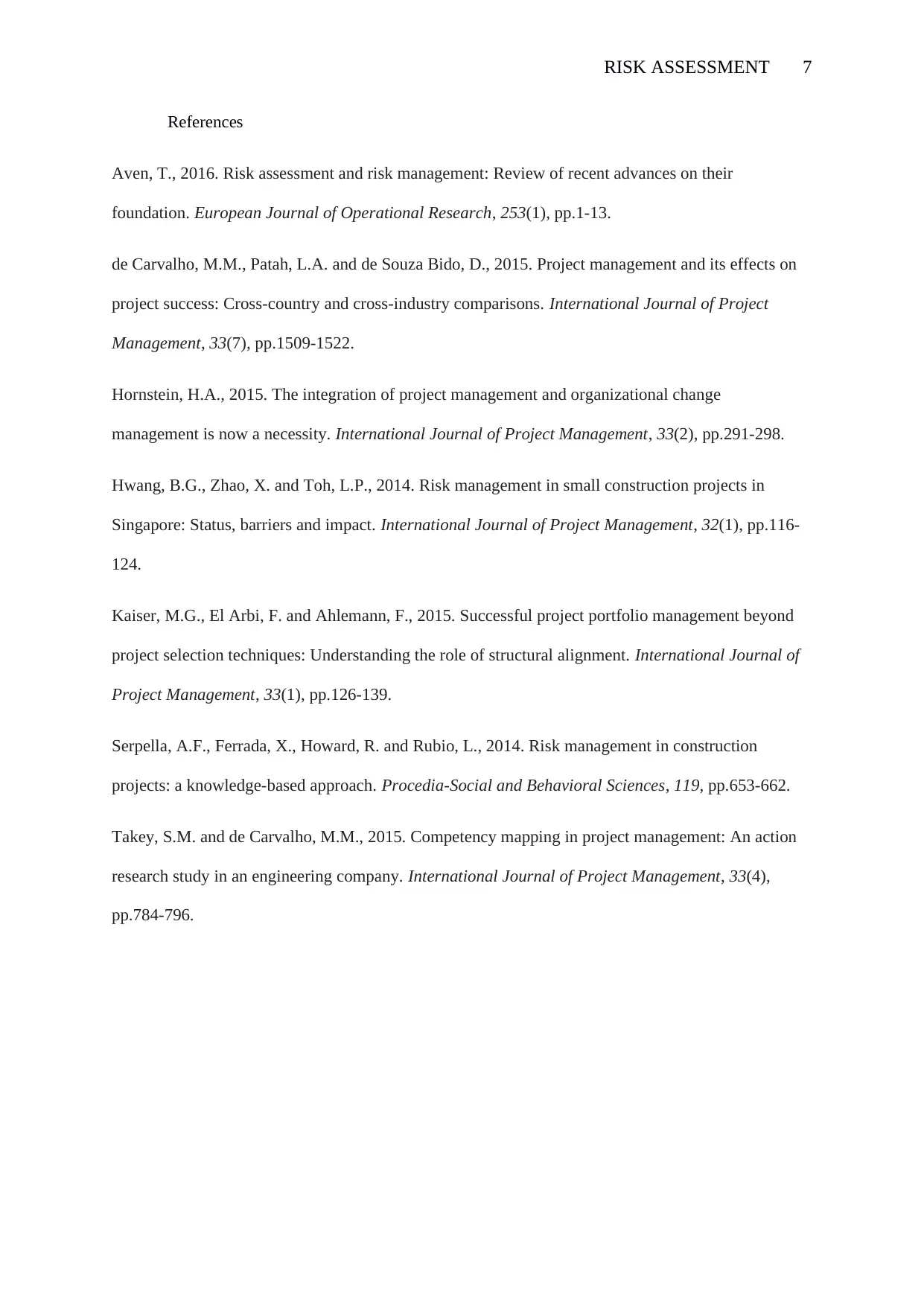
RISK ASSESSMENT 7
References
Aven, T., 2016. Risk assessment and risk management: Review of recent advances on their
foundation. European Journal of Operational Research, 253(1), pp.1-13.
de Carvalho, M.M., Patah, L.A. and de Souza Bido, D., 2015. Project management and its effects on
project success: Cross-country and cross-industry comparisons. International Journal of Project
Management, 33(7), pp.1509-1522.
Hornstein, H.A., 2015. The integration of project management and organizational change
management is now a necessity. International Journal of Project Management, 33(2), pp.291-298.
Hwang, B.G., Zhao, X. and Toh, L.P., 2014. Risk management in small construction projects in
Singapore: Status, barriers and impact. International Journal of Project Management, 32(1), pp.116-
124.
Kaiser, M.G., El Arbi, F. and Ahlemann, F., 2015. Successful project portfolio management beyond
project selection techniques: Understanding the role of structural alignment. International Journal of
Project Management, 33(1), pp.126-139.
Serpella, A.F., Ferrada, X., Howard, R. and Rubio, L., 2014. Risk management in construction
projects: a knowledge-based approach. Procedia-Social and Behavioral Sciences, 119, pp.653-662.
Takey, S.M. and de Carvalho, M.M., 2015. Competency mapping in project management: An action
research study in an engineering company. International Journal of Project Management, 33(4),
pp.784-796.
References
Aven, T., 2016. Risk assessment and risk management: Review of recent advances on their
foundation. European Journal of Operational Research, 253(1), pp.1-13.
de Carvalho, M.M., Patah, L.A. and de Souza Bido, D., 2015. Project management and its effects on
project success: Cross-country and cross-industry comparisons. International Journal of Project
Management, 33(7), pp.1509-1522.
Hornstein, H.A., 2015. The integration of project management and organizational change
management is now a necessity. International Journal of Project Management, 33(2), pp.291-298.
Hwang, B.G., Zhao, X. and Toh, L.P., 2014. Risk management in small construction projects in
Singapore: Status, barriers and impact. International Journal of Project Management, 32(1), pp.116-
124.
Kaiser, M.G., El Arbi, F. and Ahlemann, F., 2015. Successful project portfolio management beyond
project selection techniques: Understanding the role of structural alignment. International Journal of
Project Management, 33(1), pp.126-139.
Serpella, A.F., Ferrada, X., Howard, R. and Rubio, L., 2014. Risk management in construction
projects: a knowledge-based approach. Procedia-Social and Behavioral Sciences, 119, pp.653-662.
Takey, S.M. and de Carvalho, M.M., 2015. Competency mapping in project management: An action
research study in an engineering company. International Journal of Project Management, 33(4),
pp.784-796.
1 out of 7
Related Documents
Your All-in-One AI-Powered Toolkit for Academic Success.
+13062052269
info@desklib.com
Available 24*7 on WhatsApp / Email
![[object Object]](/_next/static/media/star-bottom.7253800d.svg)
Unlock your academic potential
Copyright © 2020–2025 A2Z Services. All Rights Reserved. Developed and managed by ZUCOL.





